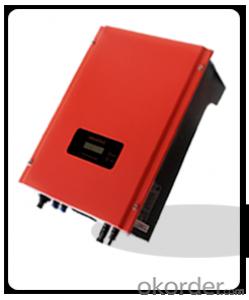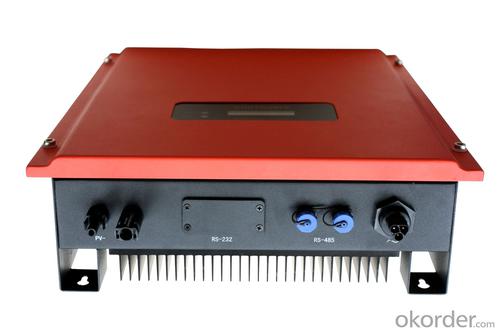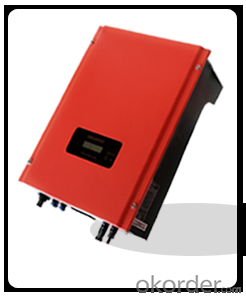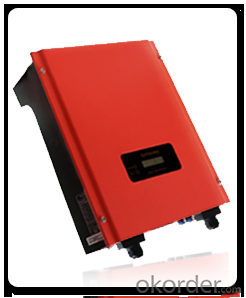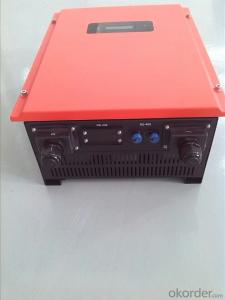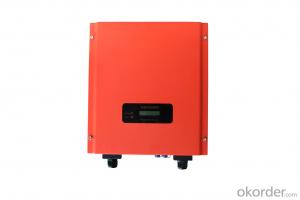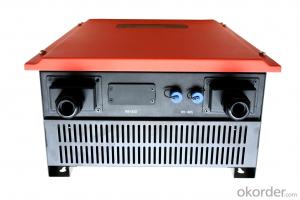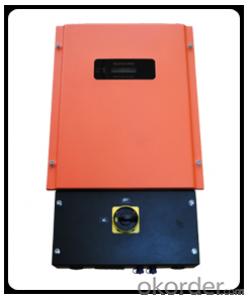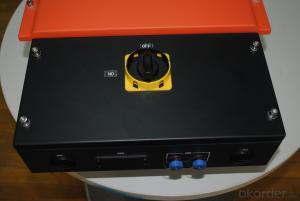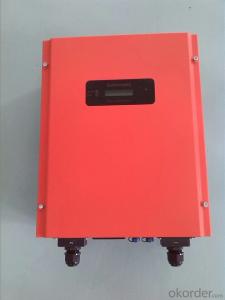Solar Inverters Sunteams 1500 to 3000 US ETL from China
- Loading Port:
- China main port
- Payment Terms:
- TT or LC
- Min Order Qty:
- 1 watt
- Supply Capability:
- 10000000 watt/month
OKorder Service Pledge
OKorder Financial Service
You Might Also Like
Description:
The Sunteams (US) 1500 ~5000 series isapplicable to various rooftops and small scale photovoltaic grid connected power plants. Their nominal output powers are 1.5 kW, 2 kW, 2.5 kW, 3 kW, 4 kW and 5kW respectively with Certificate ETL (220V/60HZ).
This series is transformerless and has a wide range of MPPT input voltage. Itsmaximum conversion efficiency and MPPT tracking accuracy reach 97.6 % and 99.5% respectively. The maximum DC voltage reaches 550 V. Its multilingualLCD display facilitates easy operation. It has waterproof direct plug-interminals. It has overvoltage, islanding, short-circuit, overloading andoverheating protection functions. Its IP65 protection degree will ensure itruns well in various tough environments.
These units are available with or without wirebox.
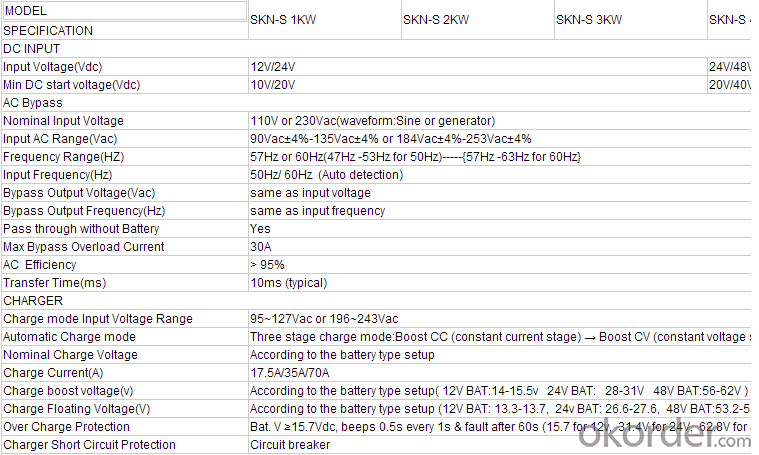
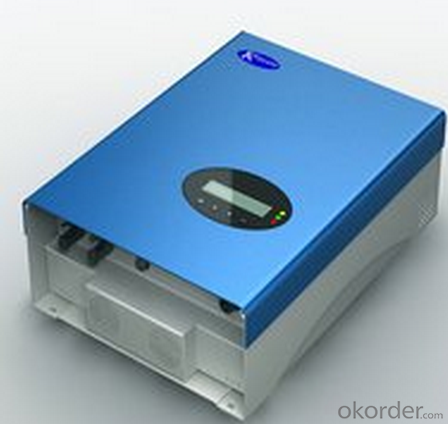
FAQ:Pls introduce more about CNBM?
CNBM is a China state owned company ,one of Global Fortune 500 .
- Q: How does a solar inverter communicate with other components of a solar power system?
- A solar inverter communicates with other components of a solar power system through wired or wireless connections. It typically uses communication protocols such as Modbus, CAN bus, or Ethernet to exchange data with devices such as solar panels, batteries, energy meters, and monitoring systems. This communication enables the inverter to receive information about the solar panel's output, battery status, and energy consumption, allowing it to optimize power generation and manage energy flow within the system.
- Q: What is the role of a galvanic isolation transformer in a solar inverter?
- The role of a galvanic isolation transformer in a solar inverter is to provide electrical isolation between the input (solar panels) and the output (power grid). This isolation helps in preventing any electrical noise, surges, or ground loops from affecting the solar inverter or the power grid, ensuring safe and reliable operation. Additionally, the galvanic isolation transformer helps in maintaining the required level of insulation and protection, complying with safety standards and regulations.
- Q: What is the role of power factor correction in a solar inverter?
- The role of power factor correction in a solar inverter is to improve the efficiency and stability of the system by minimizing the reactive power and optimizing the power factor. This ensures that the inverter operates at its highest efficiency and reduces any voltage drops or disturbances in the grid. Additionally, power factor correction helps to comply with grid regulations and standards, preventing penalties and ensuring smooth integration of solar power into the electrical grid.
- Q: How does a solar inverter handle voltage and frequency variations caused by load shedding?
- A solar inverter is designed to handle voltage and frequency variations caused by load shedding by having built-in mechanisms and control systems. When load shedding occurs and the grid voltage or frequency deviates from the normal range, the solar inverter detects these variations and adjusts its operation accordingly. To handle voltage variations, the solar inverter employs a voltage regulation system. It continuously monitors the grid voltage and compares it with the standard voltage level. If the grid voltage decreases or increases beyond the acceptable range, the inverter adjusts its internal voltage conversion process to maintain a stable output voltage. This ensures that the connected solar panels continue to generate power within the acceptable voltage limits, minimizing any negative effects due to voltage fluctuations. Similarly, for frequency variations caused by load shedding, the solar inverter has a frequency regulation mechanism. It monitors the grid frequency and compares it with the standard frequency level. In cases of frequency deviations, the inverter adjusts its internal synchronization process to match the grid frequency. This allows the inverter to synchronize with the grid and feed the generated solar power in a manner that is compatible with the grid's frequency. In addition to voltage and frequency regulation, solar inverters often have additional functionalities to enhance their ability to handle variations caused by load shedding. These may include features such as anti-islanding protection, which ensures that the solar system disconnects from the grid during a power outage to prevent safety hazards to utility workers attempting to restore power. Furthermore, some advanced inverters can also have energy storage capabilities, allowing them to store excess solar energy and provide uninterrupted power supply during load shedding events. Overall, solar inverters are specifically designed to handle voltage and frequency variations caused by load shedding. Through their regulation and control systems, they ensure that the solar power generated from the panels remains stable and compatible with the grid, providing a reliable and efficient power supply even during challenging grid conditions.
- Q: Can a solar inverter be used with solar-powered agricultural equipment?
- Yes, a solar inverter can be used with solar-powered agricultural equipment. A solar inverter is an essential component of a solar power system as it converts the direct current (DC) electricity generated by solar panels into usable alternating current (AC) electricity. This AC electricity can then power various agricultural equipment, such as irrigation systems, pumps, and machinery, allowing them to operate efficiently using clean and renewable solar energy.
- Q: What is the importance of voltage and frequency control in a solar inverter?
- The importance of voltage and frequency control in a solar inverter is crucial for maintaining the stability and reliability of the power output. By regulating the voltage and frequency levels, the inverter ensures that the electricity generated from the solar panels is in sync with the grid requirements. This control is necessary to prevent damage to electrical appliances and equipment, maintain grid stability, and enable seamless integration of solar energy into the existing power system.
- Q: What is the power factor correction capability of a solar inverter?
- The power factor correction capability of a solar inverter refers to its ability to adjust the power factor of the electricity it produces. A power factor is a ratio that measures the efficiency of electrical power usage, with a value between 0 and 1. A solar inverter with good power factor correction capability can optimize the power factor towards unity (1), which indicates maximum efficiency. This helps in minimizing reactive power and reducing energy wastage, resulting in a more efficient and effective utilization of solar power.
- Q: Can a solar inverter be used in systems with different module currents?
- Yes, a solar inverter can be used in systems with different module currents. Solar inverters are designed to convert the DC power produced by the solar panels into AC power for use in the electrical grid or for powering appliances. They typically have a wide range of input voltage and current ratings to accommodate different solar panel configurations. As long as the total power output of the solar panels is within the specifications of the inverter, it can be used in systems with varying module currents.
- Q: Can a solar inverter be used with a solar-powered food dehydrator?
- Yes, a solar inverter can be used with a solar-powered food dehydrator. The solar inverter helps convert the direct current (DC) produced by the solar panels into alternating current (AC) that can be used by the food dehydrator. This allows the dehydrator to operate using the energy generated by the solar panels, making it an efficient and sustainable option for food dehydration.
- Q: Are there any safety considerations when installing a solar inverter?
- Yes, there are several safety considerations when installing a solar inverter. First, it is important to ensure that the installation is carried out by a qualified professional who is trained in handling electrical systems. This helps minimize the risk of electric shock or fire hazards. Additionally, proper grounding and insulation must be implemented to prevent electrical faults. It is also crucial to follow the manufacturer's guidelines and local electrical codes to ensure the safe and efficient operation of the inverter.
Send your message to us
Solar Inverters Sunteams 1500 to 3000 US ETL from China
- Loading Port:
- China main port
- Payment Terms:
- TT or LC
- Min Order Qty:
- 1 watt
- Supply Capability:
- 10000000 watt/month
OKorder Service Pledge
OKorder Financial Service
Similar products
Hot products
Hot Searches
Related keywords

